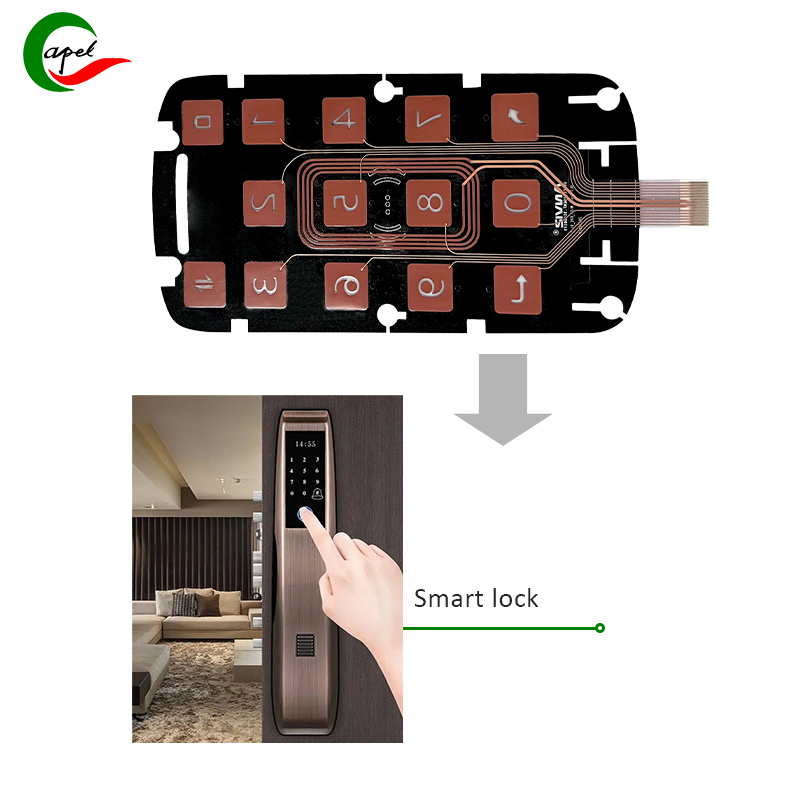Smart door locks have revolutionized the security and convenience of modern homes and commercial buildings. As a rigid-flex PCB engineer with over 15 years of experience in the smart door lock industry, I have witnessed and contributed to the development of smart lock solutions using cutting-edge technology. In recent years, the integration of rigid-flex PCB technology has played a key role in solving industry-specific challenges and enhancing the functionality and reliability of smart door locks. This article aims to demonstrate a successful case study of how the application of rigid-flex PCB technology has led to innovative smart lock solutions that effectively address the unique challenges faced in the new energy sector.
Introduction to Rigid-Flex PCB Technology and Smart Door Locks
Rigid-flex PCB technology enables seamless integration of rigid and flexible circuit substrates, thereby improving design flexibility and space optimization of electronic devices. As a key component of security and access control systems, smart door locks require advanced electronic systems to ensure strong performance and user-friendly functionality. As the demand for smart door locks continues to grow, there is an increasing need to overcome industry-specific challenges, especially in the new energy sector where energy efficiency, sustainability and reliability are critical.
Rigid-flexible PCB technology in smart lock solutions
It has been proven that the integration of rigid-flexible PCB technology in smart lock solutions can help solve various challenges encountered in the new energy field. This section presents successful case studies where the application of rigid-flex PCB technology has resulted in innovative and effective solutions.
Energy-Efficient Power Management
One of the major challenges in the new energy sector is the need for energy-efficient smart door locks that minimize power consumption without compromising performance. In a case study conducted by our engineering team, the implementation of rigid-flex PCB technology made it possible to develop a smart lock system with advanced power management capabilities. By integrating flexible and rigid substrates, the design can efficiently harvest energy from environmental sources, such as solar or kinetic energy, while also maximizing the use of energy storage components. This solution not only meets energy efficiency requirements but also contributes to the overall sustainability of the smart lock system.
Durability and Environmental
Resistance Smart door locks installed in outdoor environments or high-traffic areas are exposed to harsh environmental conditions and mechanical stress. By using rigid-flex PCB technology, our team successfully developed a smart lock device solution that offers superior durability and environmental resistance. The flexible substrate enables seamless integration of sensors, actuators and communication modules within a compact yet robust form factor, while the rigid portion provides structural integrity and protection from moisture, dust and temperature changes. As a result, this smart lock solution demonstrates reliable performance under challenging environmental conditions, making it suitable for applications in the new energy sector.
Enhanced connectivity and wireless integration
In the field of new energy, smart home door locks often need to be seamlessly integrated with wireless communication protocols and energy management systems. Our experience in leveraging rigid-flex PCB technology to optimize connectivity and wireless integration has resulted in significant advances in smart lock solutions. Through careful design and layout considerations, we are able to integrate antennas, RF modules, and communication interfaces into rigid-flex structures, enabling reliable and efficient wireless communications. This capability has proven critical to achieving seamless integration with energy management systems and smart grid infrastructure, helping to improve overall energy efficiency and sustainability.
Miniaturization and Space Optimization
As the trend toward compact and integrated smart lock designs continues, miniaturization and space optimization of electronic components have become key goals. Rigid-flex PCB technology enables us to provide innovative smart lock solutions that meet these needs. By leveraging flexible substrates to create complex 3D interconnects and integrating components in multiple planes, our engineering team achieves significant space optimization without compromising performance or reliability. This approach not only facilitates the development of stylish and compact smart lock designs, but also contributes to the efficient use of materials and resources, in line with sustainable development goals in the new energy sector.
Conclusion
The successful case studies presented in this article highlight the key role of rigid-flexible PCB technology in bringing new opportunities for smart security lock solutions in the new energy sector. The integration of rigid-flex PCB technologies facilitates the development of advanced smart lock systems that meet industry-specific requirements by solving energy efficiency, durability, connectivity and space optimization challenges. As the smart door strikes lock industry continues to develop, the application of rigid-flexible PCB technology will undoubtedly play a vital role in promoting innovation and meeting the changing needs of the new energy field.
In conclusion
my extensive experience as a rigid-flex PCB engineer in the smart door lock industry has provided me with valuable insights into the potential of this technology in delivering smart, sustainable and reliable smart lock solutions. Focusing on innovative design, energy efficiency and environmental sustainability, the integration of rigid-flex PCB technology will continue to drive the development and adoption of smart lock solutions in the new energy sector.
Post time: Dec-20-2023
Back







